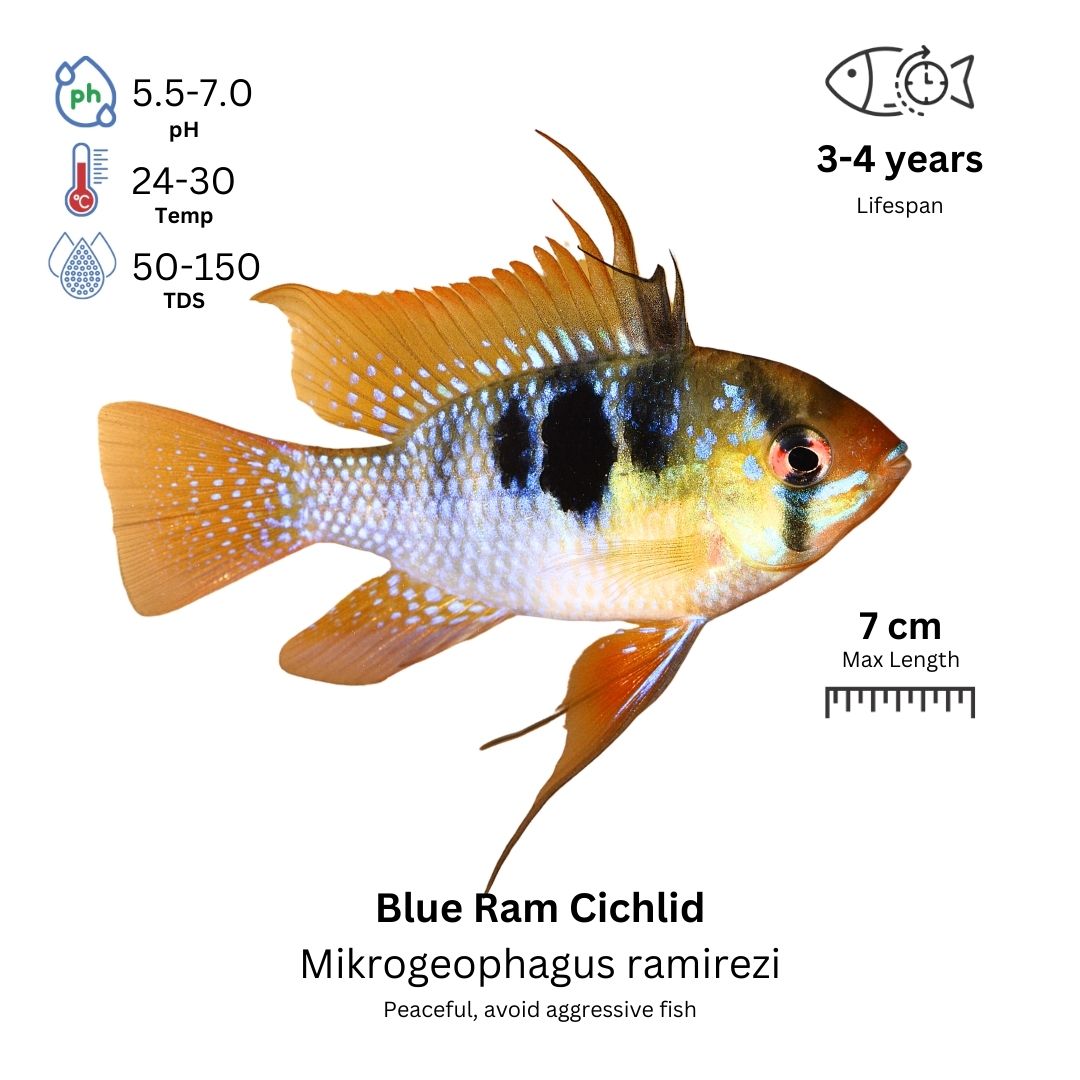Blue Ram Cichlid: A Guide for Aquarium Enthusiasts
The Blue Ram Cichlid (Mikrogeophagus ramirezi) is a small yet stunning freshwater fish known for its vibrant blue iridescence, peaceful nature, and unique personality. Popular among aquarists, this species thrives in well-maintained community tanks and is ideal for both beginners and experienced hobbyists.
Characteristics
- Scientific Name: Mikrogeophagus ramirezi
- Common Name: Blue Ram Cichlid, German Blue Ram
- Family: Cichlidae
- Natural Habitat: Found in slow-moving waters, tributaries, and floodplains in Venezuela and Colombia.
- Behavior: Peaceful and social, but can be mildly territorial during breeding.
- Tank Preferences: Prefers a heavily planted tank with hiding spaces and open swimming areas.
- Ideal Water Parameters:
- pH: 6.0 – 7.5
- Hardness: Soft to moderate (3-10 dGH)
- Temperature: 25-30°C (77-86°F)
- Care Level: Moderate
Origin and Distribution
The Blue Ram Cichlid originates from South America’s Orinoco River Basin, where it thrives in soft, warm waters with dense vegetation. It has been selectively bred in captivity to enhance its brilliant blue coloration.
Colors and Markings
- Body Color:
- Iridescent blue with hints of yellow and gold.
- Black markings, including a dark eye stripe and a vertical spot on the body.
- Fins: Transparent to red-tinted, with blue speckles.
- Size: 5-7 cm (2-3 inches) when fully grown.
Tankmates
- Best Companions:
- Peaceful tetra species (Rummy Nose Tetra, Cardinal Tetra).
- Other small cichlids (Apistogramma, Bolivian Rams).
- Bottom dwellers like Corydoras and Otocinclus Catfish.
- Avoid:
- Aggressive or fin-nipping fish like Tiger Barbs.
- Large or overly active fish that may stress them.
Care Requirements
- Tank Size: Minimum 20 gallons for a pair.
- Filtration:
- Use gentle filtration (sponge or canister filters) to prevent strong currents.
- Maintain crystal-clear water quality to keep them healthy.
- Water Changes: 20-30% weekly to maintain stability.
- Lighting: Moderate to low; enhances their natural colors.
- Substrate & Decor:
- Fine sand or soft gravel to mimic their natural environment.
- Live plants (Java Fern, Amazon Sword, Anubias) for shelter.
- Driftwood and caves for hiding and breeding sites.
Diet and Feeding
- Diet Type: Omnivore
- Food Recommendations:
- High-quality cichlid pellets and flakes.
- Live or frozen foods (bloodworms, daphnia, brine shrimp).
- Occasional vegetable matter (blanched spinach, spirulina flakes).
- Feeding Frequency: Twice a day in small portions.
Gender Differences
- Males: Slightly larger, more extended dorsal fin, and brighter colors.
- Females: Smaller, rounder body, with a pinkish belly (especially when breeding).
Breeding
- Difficulty: Moderate
- Breeding Requirements:
- Keep a bonded pair in a separate tank for successful breeding.
- Maintain water temperature at 28-30°C to encourage spawning.
- Egg Laying & Parental Care:
- Females lay 100-300 eggs on flat surfaces or inside caves.
- Both parents care for and guard the eggs.
- Fry hatch in 3-4 days and become free-swimming after a week.
- Fry Care:
- Feed fry infusoria or baby brine shrimp for proper growth.
- Keep water parameters stable for survival.
Additional Resources
If you love Blue Ram Cichlids, you may also enjoy:
- Bolivian Ram – A hardier, slightly larger cousin of the Blue Ram.
- Apistogramma Cichlids – Another small, colorful dwarf cichlid.
- Electric Blue Acara – A peaceful yet vibrant blue cichlid.


Reviews
There are no reviews yet.